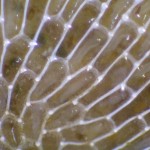Bryozoans (Phylum Bryozoa) , or ‘moss animals’ are a fascinating group of animals that I have been working on since my undergraduate honours year at the University of Melbourne.
A wholly colonial phylum, bryozoans, like most marine invertebrates, have a biphase life cycle comprising both a mobile larval stage and a sessile adult form. Larvae, which may be planktotrophic or lecithotrophic, settle out from the water column and metamorphose into the primary module, or zooid, within the colony. This primary zooid is termed the ancestrula, and the colony grows by the addition of new modules to the colony periphery.
I am interested in how the modular construction of bryozoan colonies, and the integration between modules, influences their life histories; their growth rates, reproductive modes and responses to damage and environmental change.
- Membranipora membranacea colony detail, showing the ancestral zooid in the bottom left
How do colonies recover from damage?
As modular colonial species, bryozoans have the capacity to recover lost modules, termed zooids, following physical damage through storms, wave action or predation. For my Honours work in Zoology at the University of Melbourne, Australia, I examined the recovery of the arborescent bryozoan Bugula neritina following disturbance in three different treatments; removal of all branch tips, removal of half the branch tips, and removal of a single branch. Recovery, measured as module addition and further growth, was no different across treatments, but colonies with their branch tips removed suffered a significant decrease in subsequent reproductive output.
A second experiment examined recovery following damage caused by the natural predator of B. neritina, the polycerid nudibranch Polycera hedgpethi. Damage caused by these nudibranchs had no lasting effects on either growth or reproduction, suggesting that the pattern of damage caused by this predator, typically along branches was sustainable.
Does competition for space affect damage recovery?
(to come)
How do colonies coordinate functions?
(to come)


